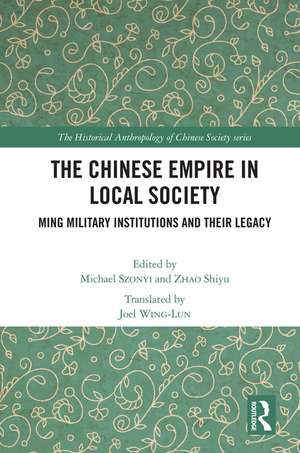The Chinese Empire in Local Society: Ming Military Institutions and Their Legacies: The Historical Anthropology of Chinese Society Series
Editat de Michael Szonyi Traducere de Joel Wing-Lun Editat de Shiyu Zhaoen Limba Engleză Paperback – aug 2022
Its nine chapters, each based on a different region of China, examine the nature of Ming military institutions and their interaction with local social life over time. Several chapters consider the distinctive role of imperial institutions in frontier areas and how they interacted with and affected non-Han ethnic groups and ethnic identity. Others discuss the long-term legacy of Ming military institutions, especially across the dynastic divide from Ming to Qing (1644-1912) and the implications of this for understanding more fully the nature of the Qing rule.
| Toate formatele și edițiile | Preț | Express |
|---|---|---|
| Paperback (1) | 260.93 lei 6-8 săpt. | |
| Taylor & Francis – aug 2022 | 260.93 lei 6-8 săpt. | |
| Hardback (1) | 1001.87 lei 6-8 săpt. | |
| Taylor & Francis – 18 dec 2020 | 1001.87 lei 6-8 săpt. |
Din seria The Historical Anthropology of Chinese Society Series
-
 Preț: 469.34 lei
Preț: 469.34 lei - 17%
 Preț: 271.61 lei
Preț: 271.61 lei -
 Preț: 390.25 lei
Preț: 390.25 lei -
 Preț: 386.00 lei
Preț: 386.00 lei -
 Preț: 384.86 lei
Preț: 384.86 lei -
 Preț: 384.44 lei
Preț: 384.44 lei
Preț: 260.93 lei
Preț vechi: 311.91 lei
-16% Nou
Puncte Express: 391
Preț estimativ în valută:
49.93€ • 52.27$ • 41.31£
49.93€ • 52.27$ • 41.31£
Carte tipărită la comandă
Livrare economică 05-19 aprilie
Preluare comenzi: 021 569.72.76
Specificații
ISBN-13: 9780367643959
ISBN-10: 0367643952
Pagini: 224
Ilustrații: 28
Dimensiuni: 156 x 234 mm
Greutate: 0.5 kg
Ediția:1
Editura: Taylor & Francis
Colecția Routledge
Seria The Historical Anthropology of Chinese Society Series
Locul publicării:Oxford, United Kingdom
ISBN-10: 0367643952
Pagini: 224
Ilustrații: 28
Dimensiuni: 156 x 234 mm
Greutate: 0.5 kg
Ediția:1
Editura: Taylor & Francis
Colecția Routledge
Seria The Historical Anthropology of Chinese Society Series
Locul publicării:Oxford, United Kingdom
Cuprins
- State Institutions, Local Society, and Historical Continuity: Ming Military Institutions from the Perspective of Historical AnthropologyMichael Szonyi and Zhao Shiyu
- The Social Impact of Changing Patterns of Military Recruitment and Logistics in Yongzhou, HunanWu Tao
- Military Colonies and Localization in Yongchun, FujianMa Wenrui and Zheng Zhenman
- The Evolution of Temples in Jinxiang Guard and the Localization of State InstitutionsZhang Kan
- State and Local Society in the Reform of the Garrison System in the Qing Dynasty: A Case Study of Yuzhou GuardDeng Qingping
- Where are the Western Aborigines?: Ningfan Guard and the Transformation of Local Society in Southwestern Sichuan in Ming and QingLong Sheng
- The Green Shoots Crop Protection Associations of Taozhou, Gansu: Ming Identities/Qing HistoriesQue Yue
- The "Civilianization" of Military Colonies and the Reorganization of Military Households: Ningxi Battalion and the Reconstruction of Rural Order in South China in the Eighteenth CenturyXie Shi
- Military Lineages and the Qing Tribute Grain System: The "Xie/Chen/Liao Barge" of Ganzhou Guard, JiangxiRao Weixin
- The Tribute Grain System, Military Colony Lands, and Transport Soldier Lineages in Ming and Qing: The Case of Huangzhou and Qizhou Garrisons of Eastern Hubei
Appendices:
I. Ming and Qing reign periods
II Ming weights and measures
III Glossary and character list
References
Notă biografică
Michael Szonyi is Frank Wen-hsiung Wu Professor of Chinese History at Harvard University.
Shiyu Zhao is Professor of History at Peking University.
Joel Wing-Lun (translator) is a doctoral student at Harvard University.
Shiyu Zhao is Professor of History at Peking University.
Joel Wing-Lun (translator) is a doctoral student at Harvard University.
Descriere
This book explores the Ming dynasty military, its impact on local society and its many legacies for Chinese society. It is based on extensive original research by scholars using the methodology of historical anthropology, an approach that has transformed the study of Chinese history by approaching the subject from the bottom up.
